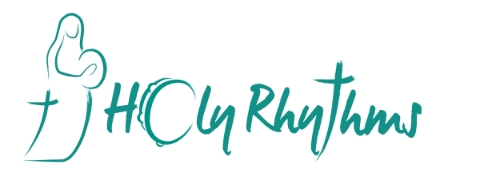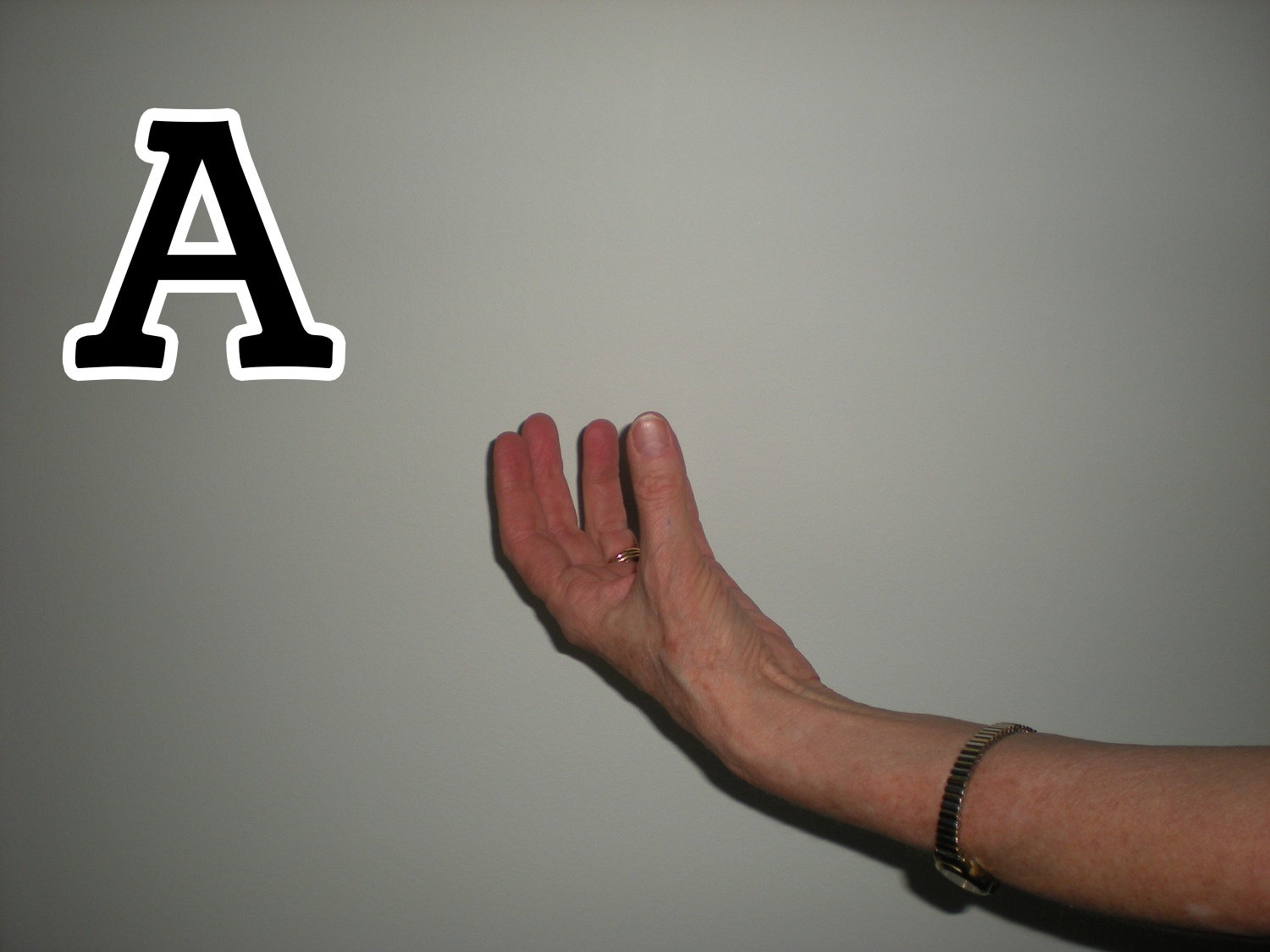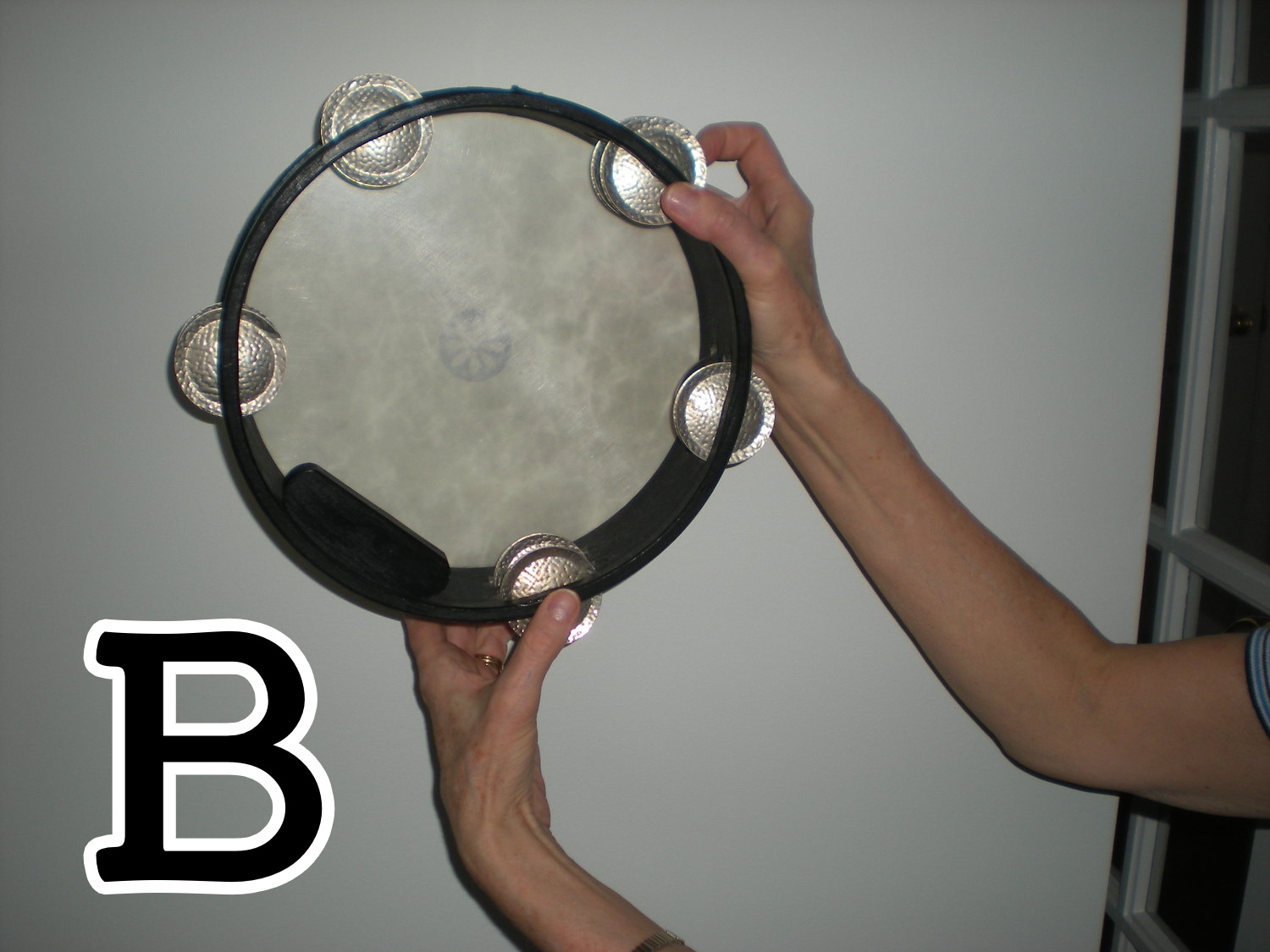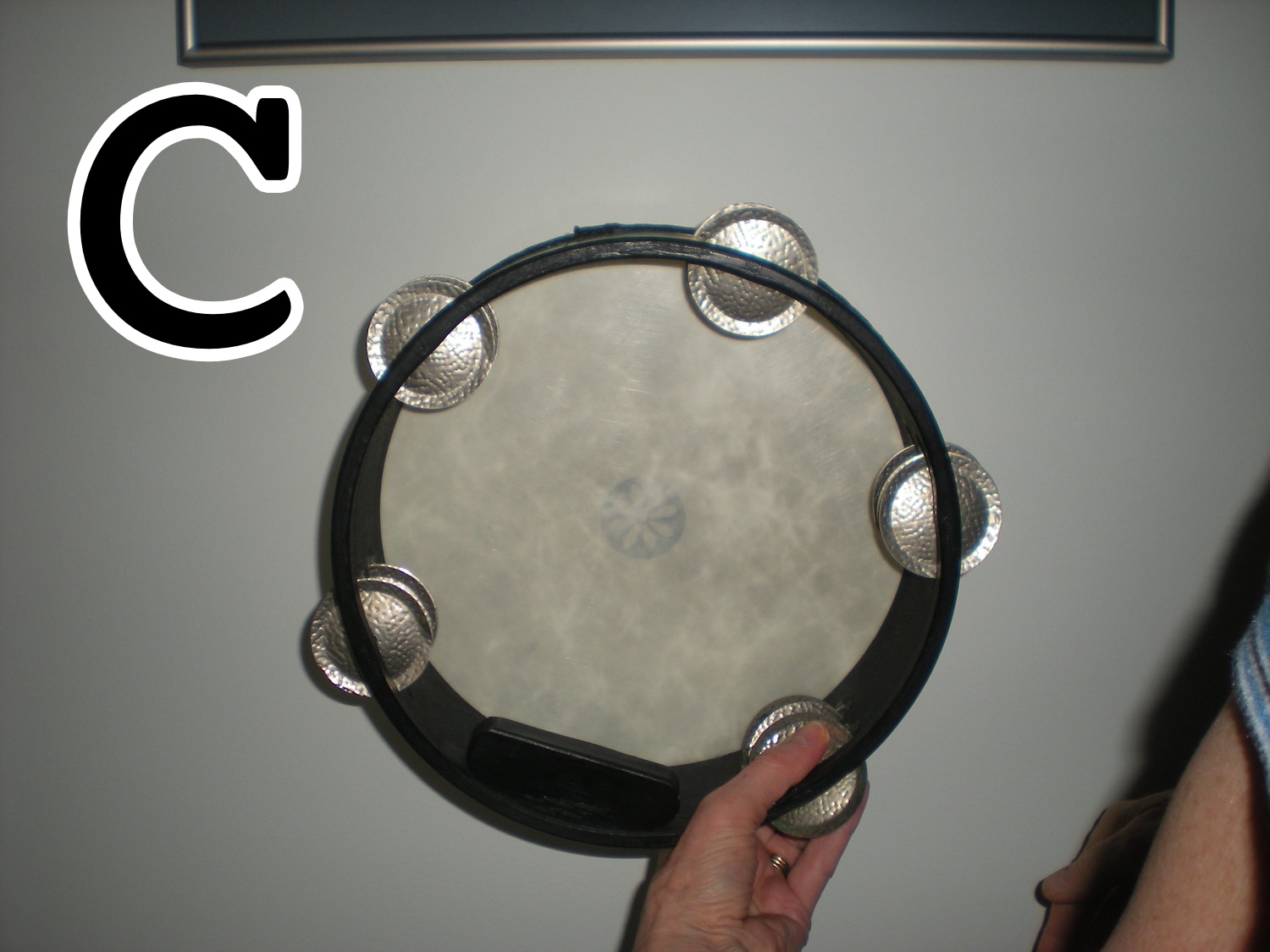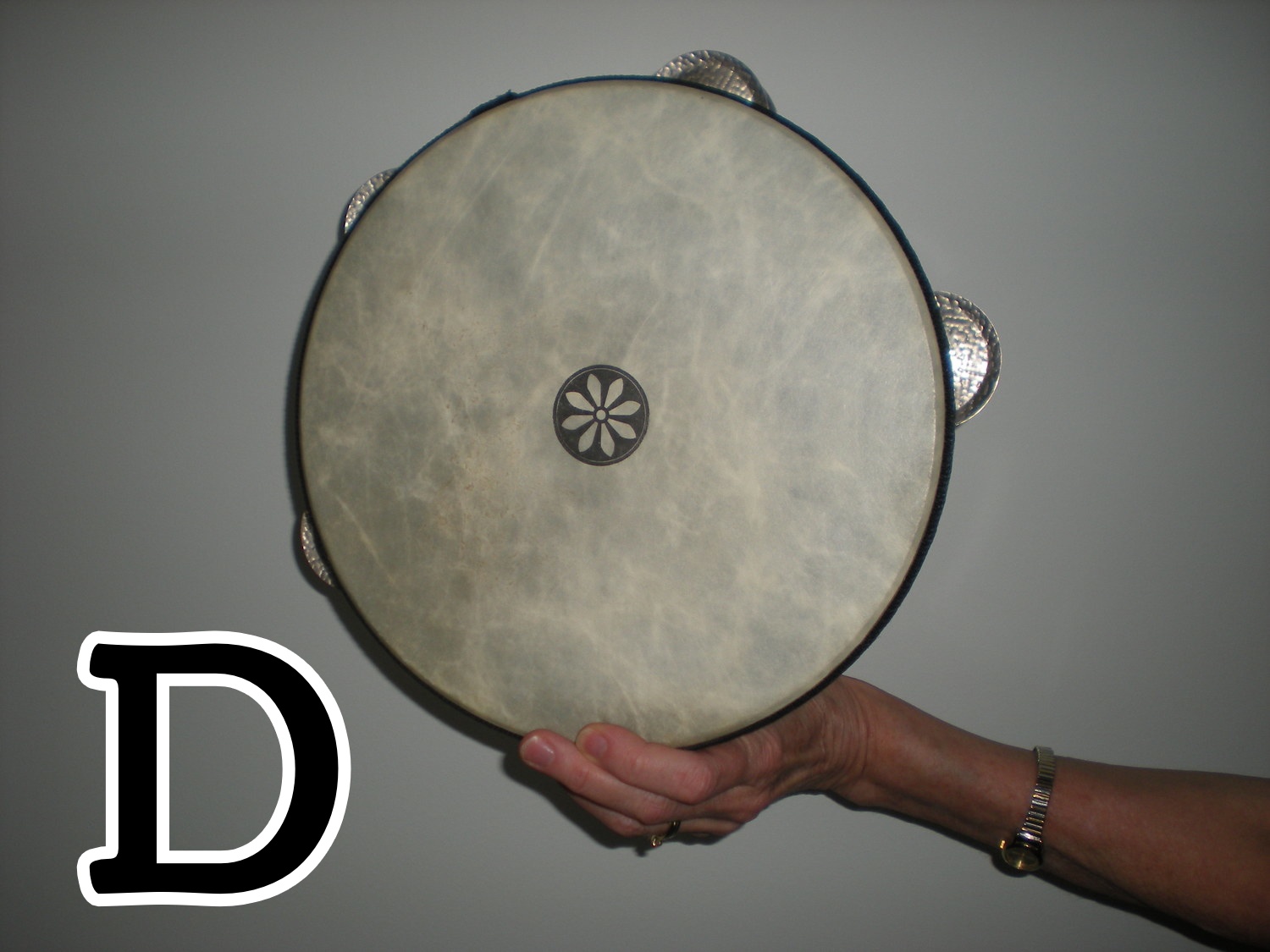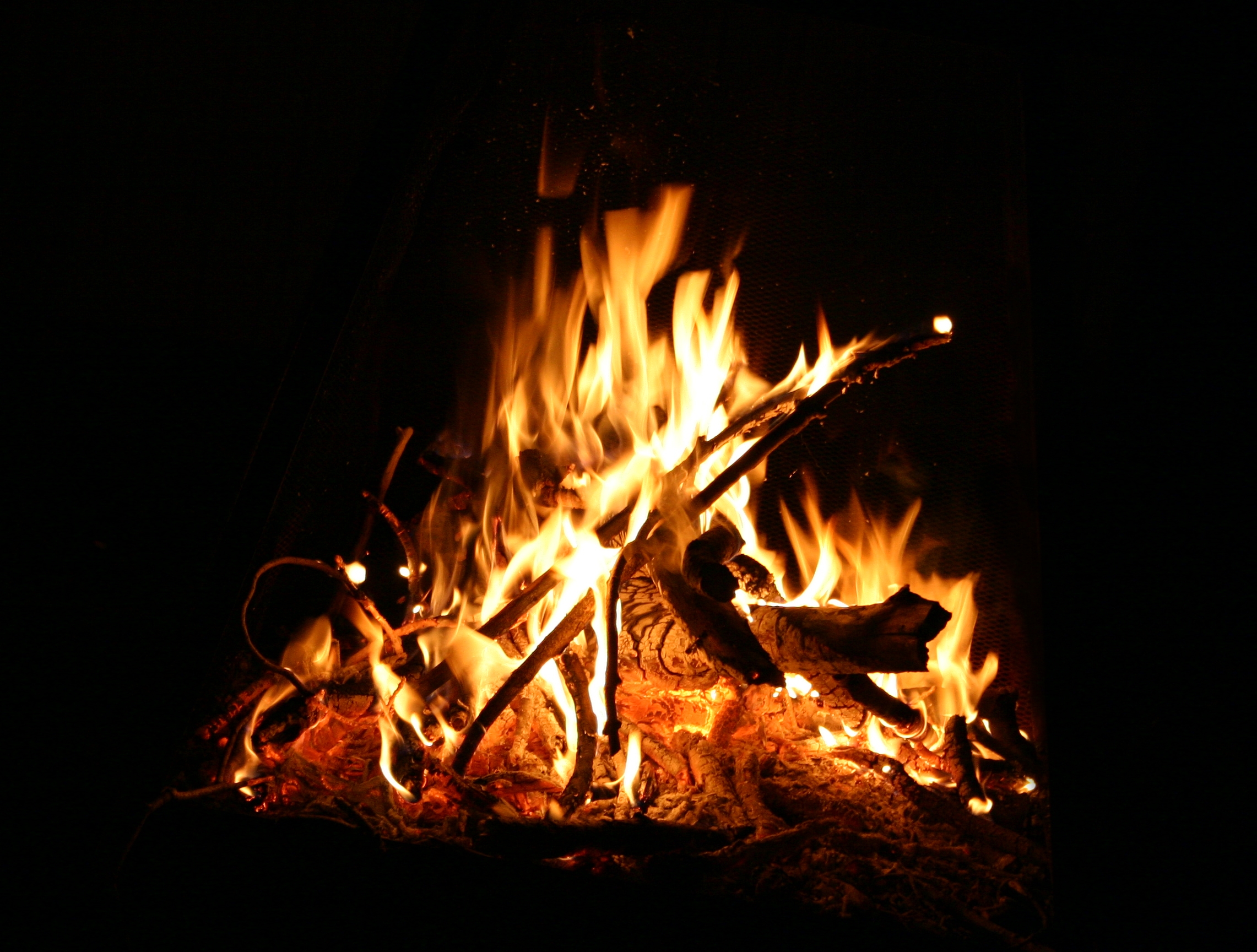Earth, Air, Fire, Water: our Elements and our Strokes
1. Holding Our Drum
We hold the tambourine frame drum in our non-dominant hand. Hold that hand like a cradle, palm up (A). Gently set the drum so that the weight block faces you and is at the bottom, resting in the cradle (B). Then slide the drum slightly around, so that, if you are right-handed, the block moves to the left of your cradle thumb. If you are left-handed rotate the drum slightly to the right of your thumb . Rest your non-dominant thumb on the jingle closest to it (C). Your index finger and tallest finger on the non-dominant hand then wrap beneath the drum and come to rest on the hard frame at the front of the drum. Make sure they lie along the frame, not on skin above the frame (D). The fourth finger or ring finger of that same hand then presses lightly against the set of jingles closest to it. With practise, this hold becomes quite comfortable. You don't need a 'death grip' on the drum, just a firm, gentle embrace.
Your drum rests in the cradle with the skin facing outward and the weight block facing you. Keep the elbow of your non-dominant hand bent at a right angle so that your arm from the elbow up to the cradle is parallel with the floor. Then turn the drum ever so slightly inward so that the dominant hand reaches the skin without needing to bend at the wrist.
Your dominant hand is now free to play the drum's four basic strokes. The drum is always held with the dominant hand's elbow also bent at a right angle, and it strokes the drum around the 3-4 o'clock position on the skin-side of the drum. This is the "sweet zone" of your drum.
Learning to hold the drum in High River United Church
2. The Drum's Four Basic Strokes
Following ancient, ancient practices of our drum tradition, each of the four basic strokes we learn synchronizes with one of the four elements out of which all creation emerges, including you and me. Earth, air, water, fire: we are all one! And the Holy flows in and through and around and before and after each one of our strokes! Can you feel the Holy as you play?
The Four Elements
Earth is the stroke Kah ( written K in patterns). The fleshy back of the tips of all five fingers on the dominant hand lightly touch or 'strike' the skin of the drum and stick briefly to the skin. Don't bounce off quickly!
Air is the stroke Cha (written C in patterns). the fleshy base of the four fingers lightly touch the wooden rim of the drum between the set of jingles where your thumb and fourth finger rest and the set of jingles just above it. Cha makes the jingles sound. The jingles need only a gentle touch on the rim!
Fire is the stroke Tak (written T in patterns). The bone in the joint nearest to the finger nail of your fourth or ring finger (dominant hand) raps sharply on the rim in the same place as you would touch for Cha. Tak is the sound of the wood in the rim when played correctly. This stroke takes a little practice to be played properly.
Water is the stroke Doum (written D in patterns). The whole index finger of the dominant hand strikes the skin of the drum and bounces off. This lets the skin vibrate when played properly. This stoke also takes practice sound correctly.
tic
The little yet powerful accompaniment stroke, tic (t), is made with the fourth finger of the non- dominant hand. Lift that finger off the jingle where it rests, and strike that same jingle crisply and cleanly. This accompaniment stroke enriches the rhythm of the 4 main strokes. We intersperse a tic, after each of the four basic strokes for example . So we practice DtDt, CtCt, TtTt and KtKt and then we try DtKt etc. and soon we can play CtCt CCtt and many more patterns. Although a 'little' accompaniment stroke, tic is a very significant stroke. Tic counts as equal in time to D, C, K and T. And, tic can become a roll and double time stroke as your skills develop and then count as 2 strokes.
3. Practice
Once the basics of each stroke is learned, each drummer aims for Precision and Endurance, keeping each stroke clear and consistent for longer and longer periods of time. If at first, your Doum does not resonate the skin, keep practising and soon you will hear one proper Doum amidst the other sounds you are making, then two Doums in a series of sounds will emerge, and in time all of your Doum strokes will resonate the skin correctly. Practice and patience are necessary. Then comes power! Beginning with 5 minutes of daily practice, you will soon want to practise more! Before you know it, your drum is an integral part of your best self and of the best part of your daily life!
4. Tar or Tambourine
When we first hear the sound of a tar, we almost always want to skip the frame drum with jingles and begin with the tar. However, the tar is more difficult to play given its weight and size and given how it is played in either the standing or seated position. The tar requires more muscle control in your arm, wrist and each finger for both its positions.
So, we begin to play on a frame drum with jingles, and then easily transfer our strength and skills to the tar.
A tambourine workshop
5. Additional resources for the Four Elements
The following resources celebrate the four elements of drumming: earth, air, fire, water. These resources enable drummers and thus worshipers to appreciate -viscerally- the 4 elements as reflected in our four strokes. Celebrating this synchronization is well suited to a worship service in Creation Time (in the Season of Pentecost) or in a thematic worship service focusing on Earth or ecology or the environment, or.....
A Hymn: "Mother Earth, Our Mother Birthing"
Words by Norm Habel and sung to the tune of "Praise, My Soul, the King of Heaven". Norm Habel has composed a large number of hymns with the theme of creaiton.
A Song: "By Breath"
Words & Music by Sara Thomsen can also be found on YouTube .
A Poem: "Fire, Water, Earth, Air"
A poem by Mary Margaret Parent and found in "In Our Own Voice: an anthology of women's spiritual journeys", Elaine Carr, et al, ed. Windsor Ontario: WOMANSPIRIT , 1995.
A chant: "The Elements"
Chapter 2 of "Circle of Song," compiled by Kate Marks (published by Full Circle Press), 1993. This is a book of simple chants and rituals. *****
6. Some Important Distinctions
How we speak about what we are doing as we drum, shapes the doing of it and it shapes us.
- We "stroke" the drum. We do not "beat" it.
- We draw out what is already within the drum, waiting for us. We don't drum to a sound we want.
- We drum to the pulse of the heart which is the pulse of creation and the pulse of God. We don't drum to a "meter." The stepping of our feet reveals the pulse as we play. So does our metronome.
- Our pulse is always slow. We don't aim to go fast and faster.
- Our drumming is not a "performance." Rather it is an offering we make (even as we are learning) to the Holy One. During worship, we are not playing "for" the congregation. Rather we strive ever and always to enable worshipers and our self to feel embraced by God, to draw closer to the Holy, to move from their heads to their hearts, to go deeper in their love of Christ.
